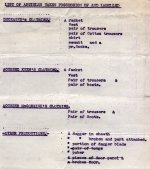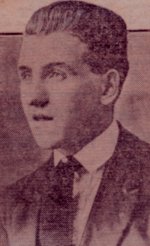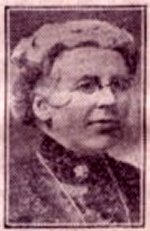Case against John Keen, Robert Fletcher, William Dayer and John McCormack, Port Dundas, Glasgow (1924-1925)
In 1925, John Keen, Robert Fletcher, William Dayer and John McCormack were accused of the assault and murder of Norrh Mohammed in Port Dundas. John Keen was charged with murder and sentence to death.
Extracts from press cuttings:
18th May, 1924
An appalling outrage was committed in Port Dundas, Glasgow, late on Saturday night when, in an outbreak of vicious hooliganism, Norrh Mohammed (27) was stabbed to death in a struggle with a gang of men. Mohammed who made a living by hawking drapery goods was approached by three men, who asked him to show them some jumpers and blouses. When Mohammed refused to do so he was beaten and stabbed. Police were called to the scene and Mohammed was taken to the Royal Infirmary, but he died before an operation could be performed.
20th May, 1925
Ten persons, nine young men and one women were arrested by Glasgow Police in connection with Norrh Mohammed's murder.
22nd May, 1925
Six of those arrested were liberated. The three men remanded were Robert Fletcher, John Keen and John McCormick.
 |
List of Productions in Mohammed case Ref: GUA FM/2B/15/1 John Glaister Senior produced a six page typed report on his examination of the productions. In his analysis, Glaister utilized a microscope, and as well as chemical and spectroscopic texts. He made extensive use of the Preciptin test, in order to test to which mammalian animal the blood groups belonged. Glaister divided the productions into four groups:
|
In his report Glaister concluded that:
Group I: Contained seven productions, consisting of clothing worn by the deceased Norrh Mohammed that stains 1 to 6 were that of mammalian blood, and that they originated from the wound found by dissections of the body of the deceased. No stains were found on production 7 (pair of socks).
Group II: Four productions comprising Group II, clothing worn by John Keen, that stains found on (1) Jacket, (2) Vest, and (4) right boot were stains of blood, but that found on the trousers was not. The stain on the toe-cap of the right boot was proved to be composed of human blood.
Group III: Three productions forming Group III, as consisting of clothing worn by John McCormick that the stains found upon both legs of the trousers were stains of blood, and from the special test employed, that these stains were composed of human blood (no stains were found on the boots or the jacket).
Group IV: The stains found on the dagger and sheath were composed of mammalian blood.
 |
17th August John Keen, John McCormick and William Dayer were charged in court charged with murder. By 3rd September charges against Dayer were withdrawn, but another man, Robert Fletcher was charged with assaulting Norrh Mohammed. Keen's Dramatic Declaration "I shall leave behind me a full written statement which will make it hot for one other man," he said. "Why were witnesses dropped who would have spoken on certain things had they been called, such as the other dagger? Instead I was picked up alone. Why should I be the only one to suffer? I thought there was justice in the High Court, but now I know there is none. I have been called a hooligan and a gangster, but this I never was." |
4th September, 1925
In the case of Fletcher, a verdict of culpable homicide was returned, and he was sentenced to seven years penal servitude. The capital charge against McCormick was dropped, but he was found guilty of intimidation and sent to prison for nine months. The jury, on which there were nine women, unanimously found Keen guilty of murder and was sentenced death by hanging.
 |
24th August There was no reprieve on Keen's execution. Mrs Bell Interviewed. Her Story of the Execution. Bailie Mrs Mary Bell [ is] the first woman to attend an execution in this country. Mrs Bell then related what she described as a rather touching little incident. "Will you shake hands with me?" Keen asked, ... Mrs Bell replied "Certainly." Turning to the actual incidents of the hanging Mrs Bell and Ballie Dunlop stood at a table which was only a yard or two distant from the drop ... Keen emerged from the cell, his hands behind his back, and a warder on either side. "An attendant put a white cap over Keen's head, the executioner touched the leer, and it was all over before I realized it had begun," continued Mrs Bell. "From the time the condemned man left his cell until completion of the execution only 45 seconds elapsed," she added. "It was a quiet, solemn, and impressive act," said Mrs Bell, who added that it had not upset her in any way, Keen, she remarked, met his death bravely. Her Obligation Giving her views on the question of capital punishment in particular reference to such a task as was hers this morning. Mrs Bell said she did not think there was a lady Magistrate or a lady Councilor in the Corporation who would not have performed the stern duty as she had done. "We must accept all the duties of our office, and when we take the oath as Magistrates we undertake to meet all the requirements of the position." "I think the nine women who sat on the jury which tried the case suffered a greater ordeal than I had." To a normal person there was nothing in the execution which could hurt the susceptibilities." Her most prominent emotion, she added, was one of great sorrow for the position of the young man, who's own act had placed him in such a terrible position. Her experience, she concluded, had not converted her to the view that the death sentence should be abolished. In certain murder cases, she maintained, this form of punishment was necessary. |
Associated material
- National Records of Scotland: Holds the trial papers of John Keen- JC26/1925/14 and associated material RHP140177, AD15/25/35

